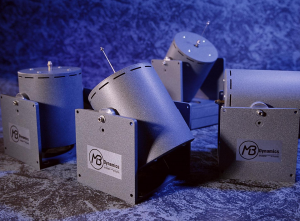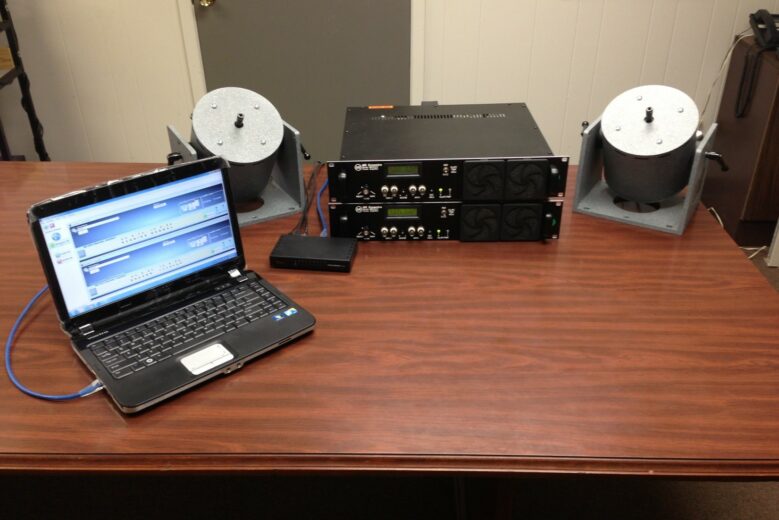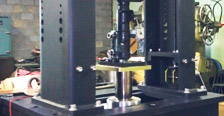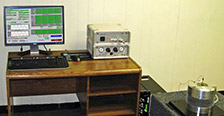Experimental modal analysis, or modal testing, is a process for physically obtaining a math model of a structure’s dynamic properties. Modal tests identify a structure’s modal properties: natural frequencies, mode shapes, mass, stiffness and damping. Modal test results help troubleshoot resonant excitation from operating forces, validate and verify finite element models, predict the benefits of structural modifications, support design verification, and understand structural responses due to complex loading conditions.
Controlled excitation tests involve exciting the structure and measuring input forces and acceleration responses at a few or many locations. Impact or hammer excitation is a quick and often effective means for modal surveys. Often, however, multiple input forces must be used, the excitation forces must be controlled, the structure is non-linear, the excitation energy must be tailored differently across different frequencies, or excitation forces must be input and distributed across the structure so as to minimize the effects of local modes or high damping. Also, the benefits of random, burst random, pseudo-random, and sine sweep and dwell excitations may be needed for good FRFs. Thus, the only option is to excite with one or more modal exciters.
Properly-featured modal exciters and amplifiers are critical to acquiring good experimental modal data and valid frequency response functions. MB’s applications know-how amassed from years and years of performing modal tests has guided MB over the last 30 years in its pioneering development of modal excitation equipment meeting the needs of modal test engineers globally. MB modal equipment eliminates the problems encountered when using traditional shakers for modal tests. MB’s range of exciters from 100N to 4000N exhibit the features knowledgeable test engineers have come to expect:
- Stinger clearance holes through the exciter armature for easy set-up.
- Collet chuck to quickly grip a smooth stinger without cutting one to a precise length.
- Lightweight armature that doesn’t mass load the test item.
- Weak armature suspension that doesn’t apply additional forces to the test item.
- Long strokes up to 50mm for flexible structures and low frequency “suspended shaker” tests.
- Thin stingers (including piano wire) decouples force inputs in all directions except the driven axis – avoids “cross axis” error in force measurement.
- Broad usable frequency range (DC to 3000+ Hz) handles almost every modal survey.
The most commonly used MB amplifiers for modal testing include user-selectable voltage or current feedback, which virtually eliminates mass loading of very small test items. MB amplifiers can be remotely operated using an embedded microcontroller with an internal network adapter having its own IP address on an Ethernet network that uses a Windows app to remotely setup, operate, gain adjust, and monitor one or any number of microcontroller-based amplifiers up to 16, especially beneficial in a multi-exciter modal test or one where the amplifiers are close to the exciters but remote from the test engineer. The amplifier’s gain can be adjusted and reset either locally on the amp’s front panel or remotely via Ethernet — duplicate and parallel functionality for all features in this option.
MB Dynamics has the most modal exciters installed worldwide for valid and reliable reasons.
| Modal 25 | Modal 50A | Modal 110 | Modal 250 | Modal 500 | Modal 1000 | |
|---|---|---|---|---|---|---|
| Force (cooled) | 25 lbf (100N) | 50 lbf (200N) | 110 lbf (500N) | 225 lbf (1000N) | 450 lbf (2000N) | 900 lbf (4000N) |
| Force (no cooling) | 13 lbf (55N) | 25 lbf (110N) | 55 lbf (250N) | 110 lbf (500N) | 225 lbf (1000N) | 450 lbf (2000N) |
| Stroke, (p-p) | 1″ (25mm) | 1″ (25mm) | 1.5″ (38mm) | 2″ (50mm) | 2″ (50mm) | 2″ (50mm) |
| Frequency Range | DC – 10kHz | DC – 5kHz | DC – 6.5kHz | DC – 4kHz | DC – 4kHz | DC – 2kHz |
| Weight, Armature | 0.3 lbs (0.14 kg) | 0.4 lbs (0.18 kg) | 1.2 lbs (0.55 kg) | 3.0 lbs (1.4 kg) | 20.5 lbs (9.3 kg) | 36 lbs (16.4 kg) |
| Weight, Shaker | 30 lbs (14 kg) | 55 lbs (25 kg) | 48 lbs (22 kg) | 250 lbs (115 kg) | 440 lbs (200 kg) | 800 lbs (364 kg) |
| Stinger Attachment | Chuck and Collet | Chuck and Collet | Chuck and Collet | Chuck and Collet | Drill Chuck | Drill Chuck |
| Stinger thru-hole | YES | YES | YES | YES | YES | YES |
| Dimensions | 9″ x 7.5″ x 9.25″ (230 x 190 x 235mm) | 11.5″ x 7.5″ x 9.25″ (290 x 190 x 235mm) | 12.3″ x 10.75″ x 12″ (315 x 275 x 305mm) | 17.19″ x 18″ x 14″ (435 x 460 x 355mm) | 20.31″ x 18″ x 14″ (516 x 460 x 355mm) | 35.8″ x 22.4″ x 19.1″ (910 x 570 x 485mm) |
| Amplifier Model | MB500VI | MB500VI | MB500VI | MB1000VI | PVL-B | PVL-S |
MODAL 25 Data Sheet: Download PDF
MODAL 50A Data Sheet: Download PDF
MODAL 110 Data Sheet: Download PDF
MODAL 250 Data Sheet: Download PDF
MODAL 500 Data Sheet: Download PDF
MODAL 1000 Data Sheet: Download PDF
MB Series Amplifier Data Sheet: Download PDF
Modal 50A
 “The MODAL 50A along with MB’s MODAL APPLICATIONS EXPERTISE have revolutionized modal testing!” This Exciter was designed by a team of world-respected modal testers, including University of Cincinnati professors, to eliminate problems encountered when using traditional shakers for modal tests. The MODAL 50A slashes setup time to a minimum! Conveniences in fixturing and setup like the clearance hole through the armature and shaker and a collet chuck for gripping a threadless stinger make easy the attachment of the MODAL 50A to a test structure. 50 pounds dynamic force from an Exciter weighing little more than 50 lbs makes it portable and easy to setup by one person.
“The MODAL 50A along with MB’s MODAL APPLICATIONS EXPERTISE have revolutionized modal testing!” This Exciter was designed by a team of world-respected modal testers, including University of Cincinnati professors, to eliminate problems encountered when using traditional shakers for modal tests. The MODAL 50A slashes setup time to a minimum! Conveniences in fixturing and setup like the clearance hole through the armature and shaker and a collet chuck for gripping a threadless stinger make easy the attachment of the MODAL 50A to a test structure. 50 pounds dynamic force from an Exciter weighing little more than 50 lbs makes it portable and easy to setup by one person.
Modal 110
 The MODAL 110 delivers 110 lbs force (500N) and 1.5” (38 mm) stroke pk-pk; has twice the force and 50% more stroke than the MODAL 50.
The MODAL 110 delivers 110 lbs force (500N) and 1.5” (38 mm) stroke pk-pk; has twice the force and 50% more stroke than the MODAL 50.
- MB’s MODAL 110 – longer – lighter – stronger – and RED!
- MB MODAL EXCITERS are the #1 selling exciters in the world — over 1300 in use worldwide!
- Light moving element mass
- Low longitudinal stiffness
- Stiff radial stiffness
- Patented flexure assembly
- Neodymium magnets
- Light-weight exciter
Modal 250

- 1,000N pk sine excitation (225 lbf); 650N RMS random (145 lbf)
- 550N pk sine excitation (125 lbf); 325N RMS random (75 lbf)
- 50mm peak-to-peak (2 in.)
- 1.75m/s peak (70 inches/second)
- 80 g pk continuous sine
- DC-1000 Hz usable to 3000 Hz
- Less than 1.4kg (3.0 lbs.)
- Approximately 2,000 Hz
- Air bearings provide outstanding sine waveform purity especially at low frequencies where flexure distortion can be troublesome (Quiet, portable compressor supplies air to bearings)
- 115kg (250 pounds)
- M6 (¼-28) female thread on shaker armature
- Floor mount with trunnion base; suspension mount with multiple turnbuckles
- 457mm X 355mm Footprint X 436mm High (18” X 14” X 17 3/16”)
- 10m (32 ft.); up to 50m (160 ft.) optional
- Turnbuckles, wrenches, M6/M10/M4 stingers X 400mm long;(Optional bolt-on-masses for additional inertia with nuts & bolts)
- Portable unit; optional Quiet Enclosure < 60dBA; or shop air
- 2,225N (500 lbs.) tension & compress; 10 mV/lb (2248 mV/kN)
Modal 500

- 2,000N pk sine excitation (450 lbf); 1,300N RMS random (290 lbf)
- 1,000N pk sine excitation (225 lbf); 650N RMS random (145 lbf)
- 50mm peak-to-peak (2 in.)
- 1.75m/s peak (70 inches/second)
- 68 g pk continuous sine
- DC-1000 Hz usable to 3000 Hz
- Less than 3.0kg (6.6 lbs.)
- Approximately 3,000 Hz
- Air bearings provide outstanding sine waveform purity especially at low frequencies where flexure distortion can be troublesome (Quiet, portable compressor supplies air to bearings)
- 200kg (440 pounds)
- M6 (¼-28) female thread on shaker armature
- Floor mount with trunnion base; suspension mount with multiple turnbuckles
- 457mm X 355mm Footprint X 516mm High (18” X 14” X 20 5/16”)
- 10m (32 ft.); up to 50m (160 ft.) optional
- Turnbuckles, wrenches, M6/M10/M4 stingers X 400mm long;(Optional bolt-on-masses for additional inertia with nuts & bolts)
- Portable unit; optional Quiet Enclosure < 60dBA; or shop air
- 2,225N (500 lbs.) tension & compress; 10 mV/lb (2248 mV/kN)

























